Heading out the door? Read this article on the new Outside+ app available now on iOS devices for members! Download the app.
Spring is a time of regeneration, growth, and expansion in our bodies, minds, and in the planning of our lives. However, according to Traditional Chinese Medicine (TCM), spring can also be a time when feelings of irritability, frustration, or anger sink in, and yoga can be an incredibly effective tool to work with them.
See also 4 Yoga for Digestion Tricks
Why We Feel Out of Balance in the Spring
In TCM, spring is associated with the wood element and an inherent sense of growth and renewal. The organs associated with the wood element are the liver and gallbladder. The liver is related to our ability to make plans and bring our goals and aspirations to life, but to do this requires flexibility in the process. Like bamboo, we must be able to bend while at the same time be strong enough to keep growing. The gallbladder represents our ability to make clear and timely decisions and the courage to carry them out.
Much like in Western medicine, in TCM, the liver and gallbladder organs are essential for our body’s capacity to process both physically (detoxification) and emotionally. In our modern-day world, the wood element (liver and gallbladder) is represented as our type A tendencies. In balance, these tendencies show up as our ability to create, cultivate, and bring our goals to life. Out of balance, they appear as stress, tension, irritability, anger, feeling stuck, restlessness, frustration, and of all the maladies that can be a manifestation of stress, in particular tension headaches, hypertension, PMS, mood fluctuations, and indigestion, to name a few.
Disharmony in the wood element can show up at any time of year, but it tends to be more predominant in the spring. With the need to move and grow, imbalance here often shows up as stagnation, so a yoga practice can be an effective way to work with this element or to help create balance.
Though there are many pathologies that can show up in the liver and gallbladder from a TCM perspective, liver qi (energy) stagnation is by far the most common. In our type A, goal-oriented society, it’s also one of the most common TCM diagnoses. Whether you work 50+ hours a week, are a full-time parent, a student, several of the above, or none of the above, you could probably benefit from a liver-focused practice to shed some of your stress, anger, and frustration.
How Yoga Can Help
The most important thing to take note of is the your quality of movement in your yoga practice. The liver thrives on smooth movement with a sense of ease. For instance, if you’re short on time, you may simply do a few slow, easy Sun Salutations to get the liver qi and circulation going. Kapalabhati pranayama is another great one when you’re short on time or don’t have your mat.
Pay close attention to the quality of your breath as well—only linger on the breath as long as there is still a sense of ease. Type A personalities usually get themselves into trouble in one of two places: moving too fast and jerky, or pushing too hard in their yoga practice. Let go of your attachment to poses looking a certain way, and focus instead on the internal quality of the pose.
As you move through your regular yoga practice this season, try connecting to a sense of free flow through the body. Look for resistant or stagnant areas and breathe through them. Spring is a great time for a group yoga class—the liver thrives on slow-flow classes to create movement and ease.
Springtime Flow to Counteract Irritability
The following practice targets the liver and gallbladder for a springtime flow to counteract irritability this season. The poses can be connected with a vinyasa for a flow-style practice, or used on their own for a more hatha-style practice. Please apply general precautions and modify to suit your body.
Pranayama-focused twist
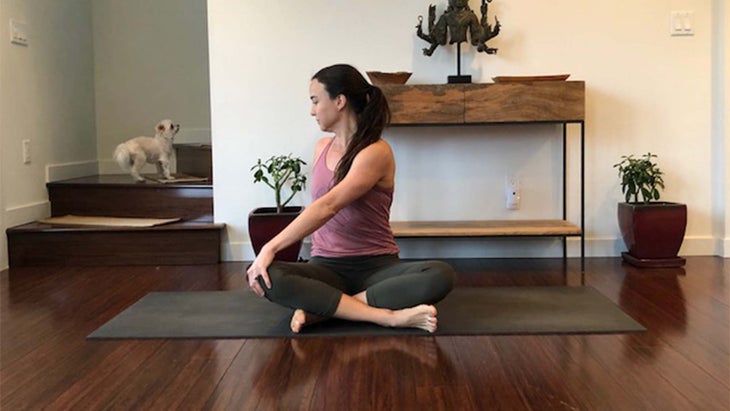
Start seated in this pranayama-focused twist to soothe the liver/gallbladder. The key here is to come into a gentle twist to target the gallbladder meridian and allow room to focus on the breath rather than the depth of the twist. From a comfortable cross-legged position in Easy Pose, twist to the right using the arms gently to assist you. Keeping your gaze ahead, with each inhale, soften halfway out of the twist. On each exhale, come back into the twist. Repeat 4-6 times. Focus on the sense of ease in your breath and use your time here to reframe your focus on the smooth flow through your cells. Repeat on the second side.
See also Pranayama for Beginners
Sun Salutation variation
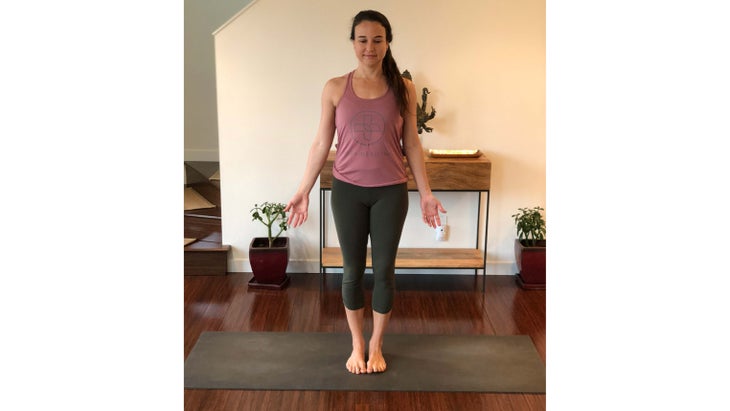
For this step, pick any Sun Salutation variation, but choose one that allows you to connect to a sense of ease in your breath. Without forcing, slow down your breath and see if you can find a brief pause at the top and bottom of the breath. Rather than holding your breath or closing the back of the throat, simply linger there. Notice how the space between the breath creates a sense of ease that you can lean into that connects you to a sense of free flow in the body. Repeat for 2-4 rounds, lingering as long as it feels welcoming in the space between the breath.
See also Why Sun Salutations Are More Than Just a Warm-Up
Warrior I with cactus arms
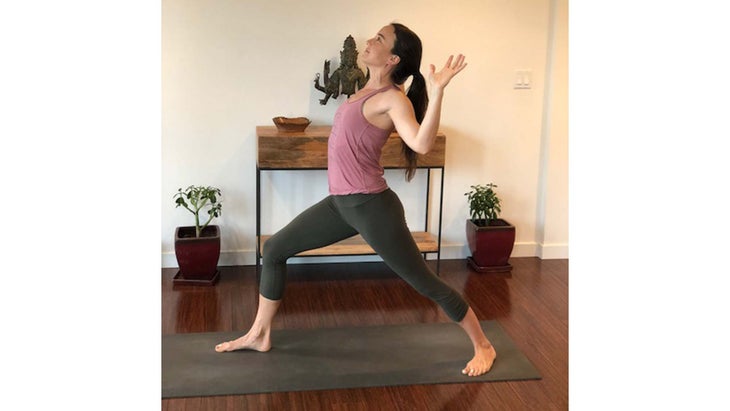
In TCM, the metal element is responsible for keeping the wood element in check (think of a metal ax cutting wood). This next variation involves a little movement and targets the lungs (the metal element organ) to pacify wood. Begin in Warrior I pose with arms by your sides. As you inhale, bend your arms into a cactus shape and open your chest. As you exhale, straighten your legs and bring your arms by your sides. The key to this one is to linger at the top of the inhale and imagine your chest still expanding. Repeat 3-5 times on each side.
See also Tiffany Cruikshank’s Meditation for Healthy Weight Loss
Extended Side Angle Pose
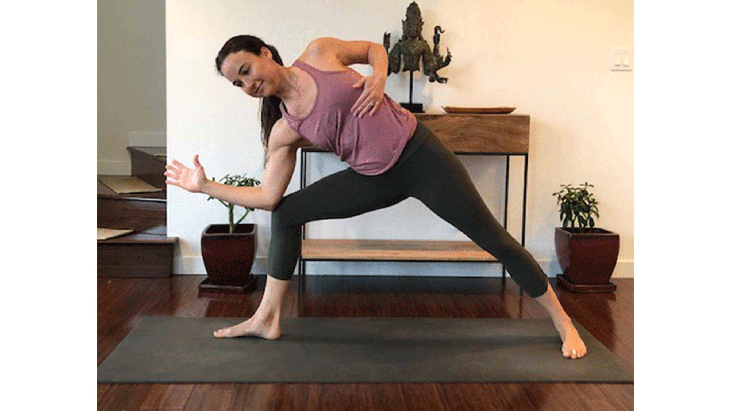
Come into Extended Side Angle Pose, keeping the chest high enough that you can lightly tap your bent elbow to your front knee. Use the other hand to draw your top ribs back as you move. Inhale, gently extend your front knee (only as much as you can comfortably, still with a sense of ease) and reach your arm forward. Exhale as you re-bend the knee and tap the elbow. Repeat 3-5 times on each side, lingering in the breath and noticing the flow of breath and energy through your body. This pose combo challenges the gallbladder meridian on the sides of the torso to be both strong and flexible, often a difficult balance with the wood element.
See also A Yogi’s Guide to the Shoulder Girdle + Its Actions
Horse Stance
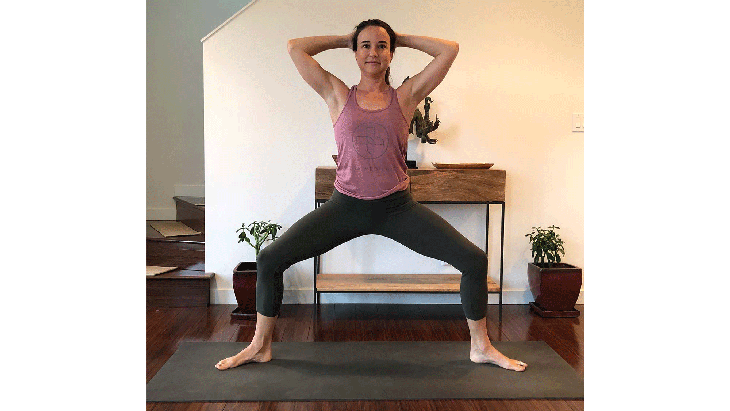
In order to move qi, we must first create warmth and malleability in the liver and gallbladder areas. From a standing position, step the feet open to Horse Stance with both feet and knees turning out about 45 degrees. Bend the knees, clasp the hands behind the head, and engage lightly all the way around the waist. Inhale to lift up through the crown of the head, exhale to side bend your elbow toward the same side knee. Inhale back to center and switch sides. Repeat 3-5 times on each side before resting in Wide-Legged Forward Bend for a few breaths.
See also Video: Stronger Core for Summer Sports
Wide-Legged Forward Bend with a twist

From Wide-Legged Forward Bend, lengthen the spine and look up on the inhale. On the exhale, twist and extend one arm up to the sky. Inhale to lower and keep lengthening the spine, then exhale, twisting to opposite side. The key here is to use your exhale to soften into the twist. If you’re comfortable there, you can linger in the twist for a moment with the breath out. Repeat 3-5 times on each side then rest for a few breaths in Wide-Legged Forward Bend.
See also Classic Asana, New Twist: 15 Traditional Poses + Variations
Half Lord of the Fishes Pose
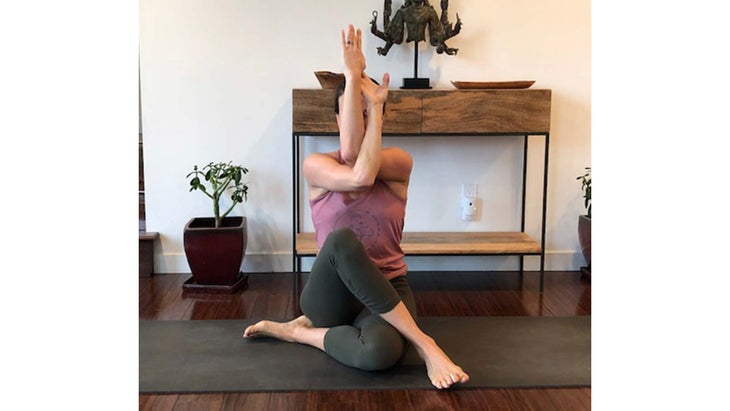
Cross the legs in a seated position for Half Lord of the Fishes Pose, then take the arms into Eagle Pose. Stay for 3-5 breaths, breathing through the back of the ribs. Then release the arms and come into Half Lord of the Fishes, loosely using the arms. Stay and notice the breath and ease here for 3-5 breaths. Then repeat on the second side.
See also 3 Prep Poses for Eagle
Child’s Pose variation
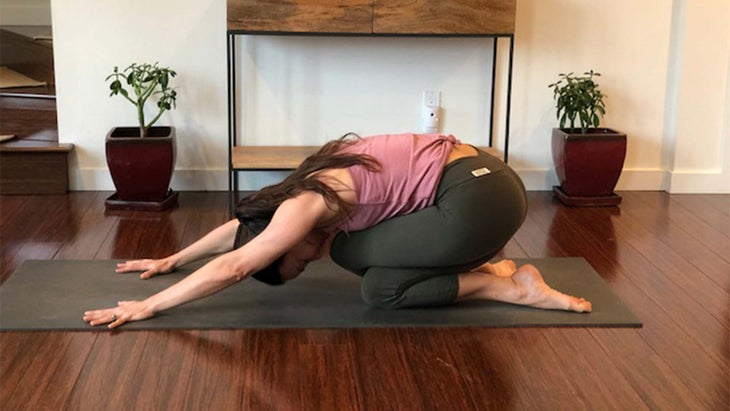
This combo targets both the wood element and the water element, which has a soothing effect on wood (think watering a dry plant). From tabletop, cross one knee over the other and sit back into this Child’s Pose variation. Let the knee come off the ground and find a comfortable place to sit here. If this doesn’t work, Child’s Pose is a great option here. Stay for a minute or two, listening to the breath and the internal experience here.
See also Find Comfort in Child’s Pose
Bow Pose
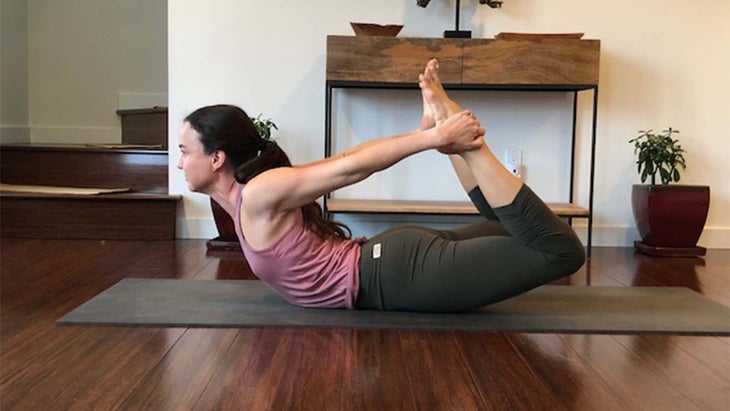
Bow Pose is another great pose to target the metal element for a pacifying effect on the wood element. Come into Bow Pose for 3-5 breaths and repeat 2-3 times.
See also Alexandria Crow’s New Way to Get Into Bow Pose
Pick an inversion
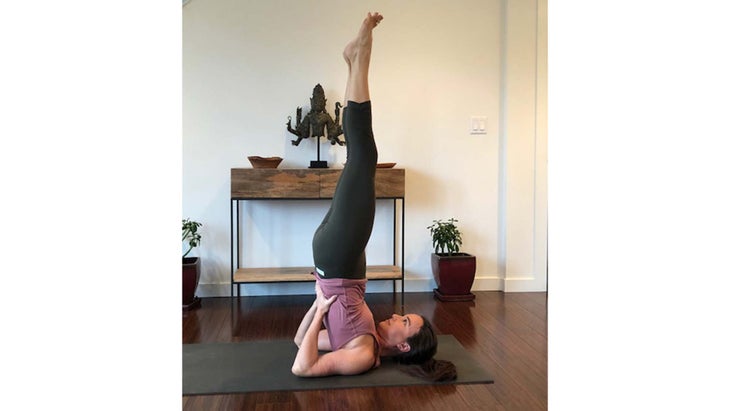
Inversions create whole-body circulation and help move the liver qi; however, this requires that you pick an inversion that doesn’t create more tension. Here, pick an inversion of your choice to stay in for 1-2 minutes. Headstand, Shoulderstand, or Legs-Up-the-Wall Pose are all excellent choices. Whichever inversion you choose, be still and notice what’s happening on a cellular level.
See also A Yogi’s Guide to Inversions
11. Lazy twist

Finally, end with a passive, lazy twist. Find a way to set yourself up to really relax here. Let your breath be natural and notice the natural ebb and flow of your breath. Stay for 1-2 minutes on each side, then transition to Savasana. As you lie down in Savasana, notice the free flow through every cell of your body. Stillness here is an important part of soothing the liver, so stay for a while and let your body soak it up.
See also Baptiste Yoga: A Twisting, Advanced Core Flow
About Our Writer
Tiffany Cruikshank, L.Ac., MAOM, is the founder of Yoga Medicine.